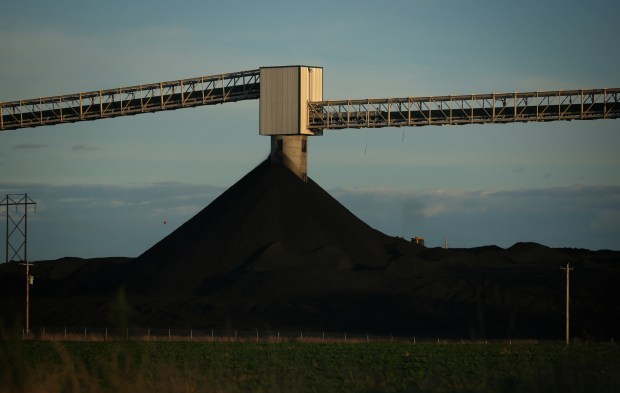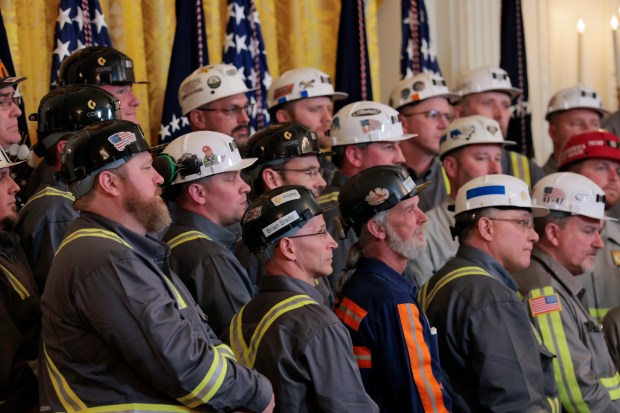Surrounded by coal miners, President Donald Trump signed an executive order vowing to roll back his predecessor’s policies limiting lung-damaging, climate-changing pollution from power plants that burn the planet’s dirtiest source of energy.
“C’mon fellas, you know what this says?” Trump said to the men in hard hats. “You’re going back to work!”
During the four years after the Republican president signed that 2017 order, and attempted to roll back dozens of clean air and water protections, 79 coal plants closed and 13,000 industry workers lost their jobs.
The number of plant closures and layoffs under Trump far exceeded those during President Barack Obama’s second term and President Joe Biden’s tenure in the White House, even as Trump and his allies accused both Democrats of waging a “war on coal.”
Like a TV network’s summer reruns, Trump is back with a pro-coal agenda. Among his targets are Illinois and other states with their own clean energy laws, which promise to end the nation’s use of coal to generate electricity and wean the nation from gas-fired power.
“This is a very important day to me because we’re bringing back an industry that was abandoned despite the fact that it was the best, certainly the best in terms of power, real power,” Trump said last week while flanked again by coal miners and corporate executives wearing hard hats at the White House.
Industry data tell another story. Coal, once a dominant sector of the economy, is in steep decline because it can’t compete against cleaner, less-expensive energy sources.
Last year coal plants generated just 15% of the nation’s electricity, down from nearly half in 2011, according to the Energy Information Administration.
Most of what’s left of Illinois’ coal fleet is scheduled to shut down within the next five years. One of Michigan’s biggest utilities, Consumers Energy, is closing the last three of its coal plants this year.
Lower prices for natural gas have prompted investor-owned companies to close scores of coal plants. Moreover, the costs of wind and solar power have dropped dramatically during the past decade and a half.
Building a new wind farm now costs 45% less than operating a coal plant with the same capacity, according to the investment firm Lazard. Solar energy is almost as cost-competitive. Renewable energy now generates more electricity nationwide than coal.
“I think you have to raise the question, is (what Trump is doing) serious?” said Barry Rabe, a professor of public policy at the University of Michigan. “Especially given the other energy sources we have available, including gas and renewables, including the interest in more nuclear (energy).”
Left unmentioned during Trump’s latest appearance with miners were the health and environmental consequences of coal.
When burned, it emits more carbon dioxide than any other fuel source. Levels of the heat-trapping gas in the atmosphere are higher than at any point during the past 800,000 years. If emissions aren’t dramatically reduced soon, decades of research show, climate-influenced catastrophes could kill millions of people and devastate the global economy.
Burning coal also creates lung-damaging smog and emits brain-damaging mercury and soot pollution that triggers respiratory ailments and shaves years off lives.
Trump’s response is a renewed attempt to eliminate limits adopted by Biden and Obama on mercury, soot, smog-forming and climate-changing pollution.
Throughout his orders, Trump cites the growing number of power-hungry data centers, though it remains unclear how much electricity the industry will need in coming years. Tech companies already are moving toward nuclear energy, and wind and solar power combined with batteries for when the wind doesn’t blow or the sun doesn’t shine.
A key roadblock is the long waitlist for wind and solar companies seeking to join regional electrical grids.
Grid operators have requested delayed closures of a few coal plants as they work through concerns about reliability. But an executive at PJM Interconnection, the nation’s largest grid operator, said at a conference last month that he wasn’t sure if the market was “sending the signal right now that coal should actually stick around.”
Nevertheless, the latest Trump-appointed administrator of the U.S. Environmental Protection Agency, former New York Republican congressman Lee Zeldin, is encouraging polluters to seek exemptions from clean air regulations. Zeldin also is moving to absolve industries from telling the public what they emit into the atmosphere — a priority in Project 2025, the far-right blueprint for Trump’s second term.
“They’re basically offering polluters ‘get-out-of-jail-free cards,’ ” said Howard Learner, president and executive director of the nonprofit Environmental Law and Policy Center.
The White House is keeping secret which companies have requested exemptions. Based on industries listed in the regulations targeted by Trump, owners of coal plants are among the potential benefactors. So are steel mills in northwest Indiana owned by U.S. Steel and Cleveland-Cliffs and oil refineries, including BP’s in Whiting, Exxon-Mobil’s outside Joliet and Citgo’s in Lemont.
Trade groups for oil companies and chemical manufacturers have asked for blanket exemptions. None of the oil companies or steel manufacturers contacted by the Chicago Tribune returned phone calls or emails. Two downstate coal plant operators, the Prairie State Generating Co. and the Southern Illinois Power Cooperative, confirmed they did not ask Trump for exemptions.

One of the chief bugaboos for fossil fuel interests is a movement among the states to create Superfund-like programs that would require polluters to pay for damages caused by climate change disasters. Trump ordered his attorney general, Pam Bondi, to block those programs and state-specific laws requiring more clean energy, including one in Illinois that bans coal- and gas-fired electricity by 2045.
“Directing the Department of Justice to address this state overreach will help restore the rule of law and ensure activist-driven campaigns do not stand in the way of ensuring the nation has access to an affordable and reliable energy supply,” Ryan Meyers, senior vice president at the American Petroleum Institute, said in a statement.
Governors and attorneys general from Democratic-led states are fighting back.
Olivia Kuncio, a spokeswoman for Illinois Gov. JB Pritzker, said Trump’s attempts to roll back environmental regulations threaten to undo or delay programs that have secured more than $4 billion in clean energy investments and created nearly 129,000 jobs.
Trump “claims to want to return rights to the states, but then acts like a dictator when state policies don’t benefit him or his cronies,” Kuncio said in an email. “If Trump and (Elon) Musk want to rail against climate policies that grow our economy while helping the environment, they’re once again proving that they care more about their rich friends than American families.”
Illinois Attorney General Kwame Raoul has joined colleagues suing the Trump administration for withholding environmental grants approved during Biden’s term.
“The recent executive orders could offer a free pass for coal power plants to inflict mercury, arsenic, other toxic pollutants on our population, including environmental justice communities,” said April McLaren, a Raoul spokeswoman who vowed he “will continue to defend our state’s protections on clean air and a healthy environment against federal overreach.”
If history is a guide, many of Trump’s pro-industry moves won’t survive court challenges.
Federal courts blocked a vast majority of environmental rollbacks attempted during Trump’s first term. His administration won just 23% of cases, compared to an average success rate of 70% during previous presidencies, according to a New York University analysis.
But the far-right Supreme Court, including three justices appointed by Trump, appears increasingly hostile to environmental regulations. Last year the court reduced the power of the EPA and other federal agencies to adopt regulations unless lawmakers spell out the details. Several cases pending before the court could further hamstring the EPA’s ability to combat climate change and industrial pollution.
Many of Trump’s pronouncements are a rehash of things his aides dissuaded him from following through on during his first four years in office. This time it appears there is nobody in the White House willing to tell him no.
John Walke, an EPA lawyer in the Clinton administration who now directs clean air policies at the nonprofit Natural Resources Defense Council, noted another difference: During the past three months Trump has repeatedly threatened major law firms, several of which have agreed to work for free on causes the president cares about, including gutting climate regulations.
“Trump is more radicalized across the board than he was in his first term,” Walke said. “Whether it’s trying to repeal the (legal finding that climate change threatens humanity) or sending tanks down Pennsylvania Avenue on his birthday, he’s still resentful that a lot of these things were blocked by people from his first term who he now calls never-Trumpers.”
“Just as there is no coherent, consistent organizing principle or explanation for how he is dealing with tariffs and global trade, it’s the same with coal,” Walke said. “I think he has these gauzy, atavistic beliefs that he’s going to bring back 1870s America coal and trade because those are the ‘glory days’ of the country.”



